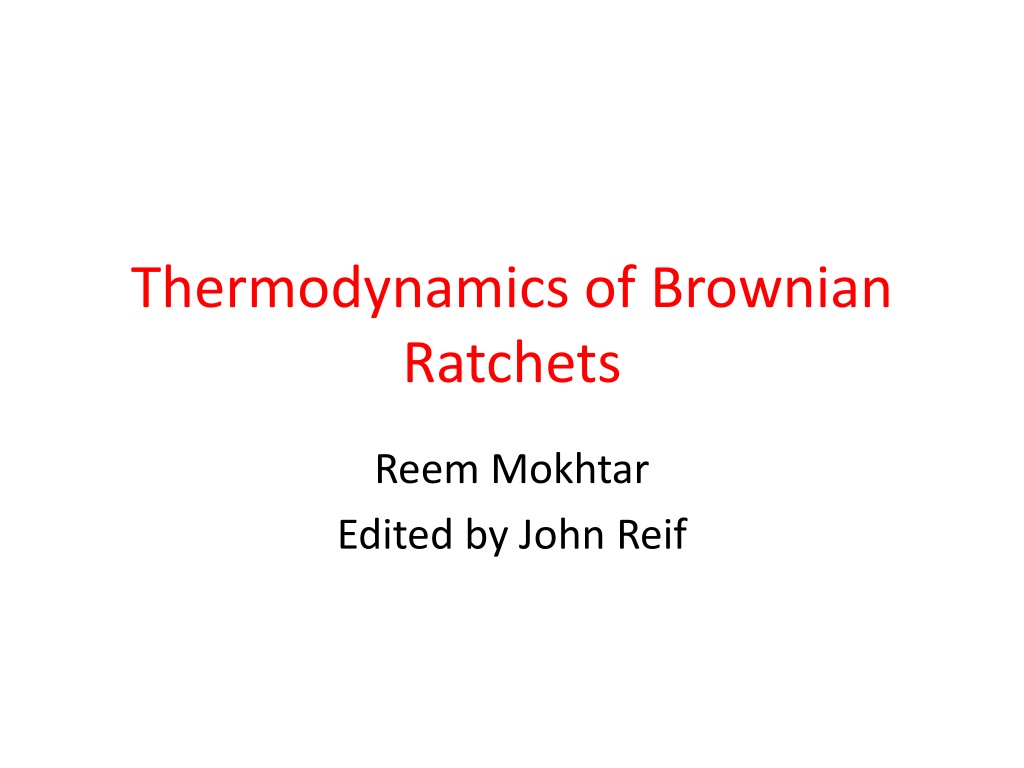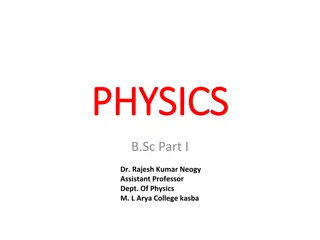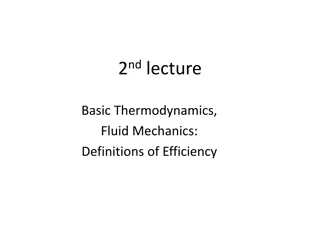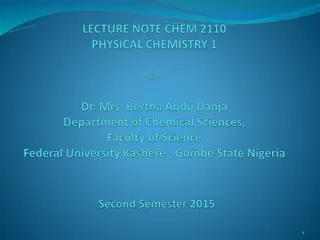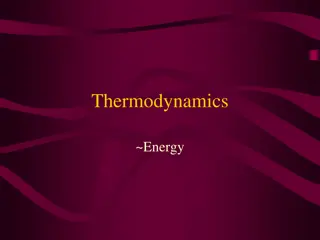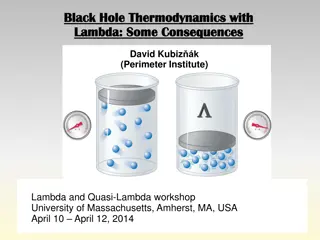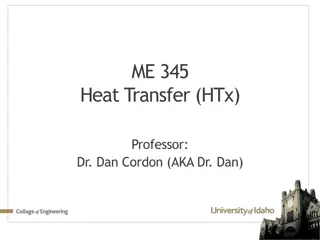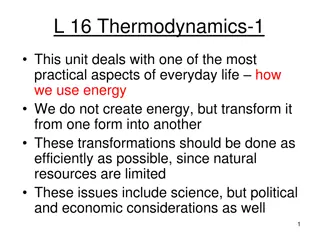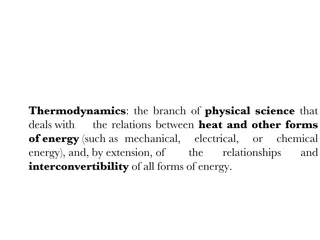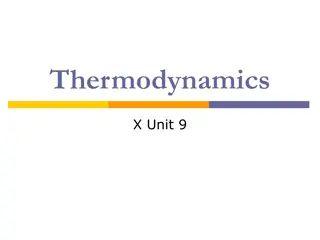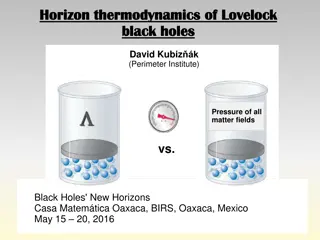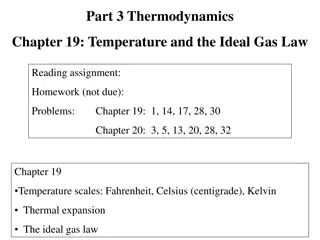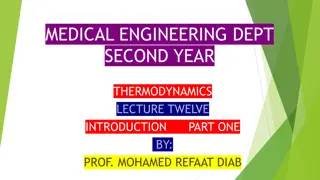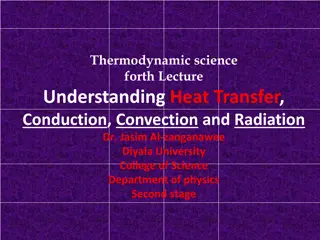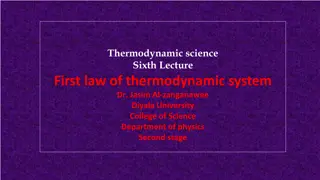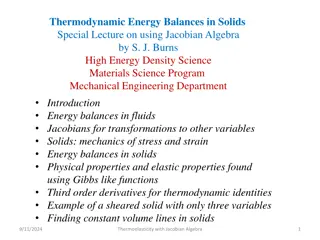Understanding Thermodynamics: Laws and Maxwell's Demon
Explore the laws of thermodynamics including the first, second, and third laws, and Maxwell's Demon thought experiment challenging the second law. Learn how entropy and energy are fundamental concepts in thermodynamics.
Download Presentation

Please find below an Image/Link to download the presentation.
The content on the website is provided AS IS for your information and personal use only. It may not be sold, licensed, or shared on other websites without obtaining consent from the author. Download presentation by click this link. If you encounter any issues during the download, it is possible that the publisher has removed the file from their server.
E N D
Presentation Transcript
Thermodynamics of Brownian Ratchets Reem Mokhtar Edited by John Reif
Thermodynamics First law of thermodynamics: the change in the internal energy of a closed system is equal to the amount of heat supplied to the system, minus the amount of work done by the system on its surroundings. The law of conservation of energy can be stated: The energy of an isolated system is constant. Second law of thermodynamics: The entropy of any isolated system not in thermal equilibrium always increases. Third law of thermodynamics : The entropy of a system approaches a constant value as the temperature approaches zero, which implies that it is impossible for any procedure to bring a system to the absolute zero of temperature in a finite number of steps Source: Wikipedia, http://en.wikipedia.org/wiki/Laws_of_thermodynamics
Maxwells Demon OK, this is another thought experiment (too much thinking here) created by physicist James Maxwell. Why on earth would he do that? Well, he was trying to say that the second law of thermodynamics wasn t ABSOLUTELY certain it only has statistical certainty. So, again, it tries to violate this second law (this is getting personal). From Wikipedia: http://en.wikipedia.org/wiki/Maxwell's_demon Another fun explanation at http://alienryderflex.com/maxwells_demon.shtml
Maxwells Demon Imagine that you have two compartments: one with hot and the other cold water. If both compartments were to be mixed together, you d reach an equilibrium, right? OK, but what if you had this little pesky hypothetical being (let s call it a demon) that can open and allow molecules through to reverse this mixing/equilibrium process, but without expending energy and separating hot from cold by only allowing molecules hotter-than-average through to one side through a door . Check out the new experiment that converts information to pure energy http://www.livescience.com/8944-maxwell-demon-converts-information-energy.html
Maxwells Demon In other words, going from a disordered (higher entropy) to an ordered system (lower entropy) without expending energy. This violates the second law of thermodynamics which says what? entropy should not decrease in an isolated system It is impossible for a device to receive heat from a single reservoir and do a net amount of work. it is impossible to extract directed motion from a random process (a single heat reservoir). It is impossible to extract an amount of heat QH from a hot reservoir and use it all to do work W . Some amount of heat QC must be exhausted to a cold reservoir. This precludes a perfect heat engine. Check out the new experiment that converts information to pure energy http://www.livescience.com/8944-maxwell-demon-converts-information-energy.html
The$ Feynman$ Lectures$ on$ Physics:$ Mechanics,$ radia7on,$ and$ heat
Feynmans Brownian Ratchet Motor Feynman s (Brownian) ratchet: what is it and what was the point of explaining it? Temp. Temp. 1. Rod 2. Paddle wheel: the fins on the left 3. A pawl: that yellow thing that forces the ratchet not to go back in the other direction 4. A ratchet: that saw toothed gear on the right 5. A spring/bearing (m) low friction, to allow rotation. (From the fun explanation @: http://gravityandlevity.wordpress.com/2010/12/07/feynmans-ratchet-and-the-perpetual- motion-gambling-scheme/)
Feynmans Brownian Ratchet Motor Feynman s (Brownian) ratchet: what is it and what was the point of explaining it? Temp. In one sentence: Temp. Where does it go wrong?: Brownian motion also affects the pawl The first moral is the Second Law itself: it is impossible to extract directed motion from a random process (a single heat reservoir). Anyone who claims they can do so is either mistaken or a charlatan. From: http://gravityandlevity.wordpress.com/2010/12/07/feynmans-ratchet-and-the-perpetual- motion-gambling-scheme/)
Feynmans Brownian Ratchet Motor Although at first sight the Brownian ratchet seems to extract useful work from Brownian motion, Feynman demonstrated that if the entire device is at the same temperature, the ratchet will not rotate continuously in one direction but will move randomly back and forth, and therefore will not produce any useful work. A simple way to visualize how the machine might fail is to remember that the pawl itself will undergo Brownian motion. The pawl therefore will intermittently fail by allowing the ratchet to slip backward or not allowing it to slip forward. Feynman demonstrated that if T1 = T2, then pawl failure rate = rate of forward ratcheting, So that no net motion results over long enough periods From Wikipedia: http://en.wikipedia.org/wiki/Brownian_ratchet
If you really wanted the thing to work You could make T2 > T1, such that the temperature is taken from the temperature gradient . Temp. Temp. BUT YOU JUST DID THE OPPOSITE OF WHAT YOU SAID YOU WANTED TO DO!! You are using TWO thermal reservoirs! There s also some heat wasted . Wait a minute this looks like a mini heat engine a system that performs the conversion of heat or thermal energy to mechanical work by bringing a working substance from a high temperature state to a lower temperature state ..which complies with the second law of thermodynamics which says what? It is impossible for a device to receive heat from a single reservoir and do a net amount of work.
Feynmans Brownian Ratchet Motor Where does it go wrong?: Brownian motion also affects the pawl The Brownian Ratchet Motor was a thought experiment, along with Maxwell s demon. It was used historically to attempt to explain away the 1) potential existence of a molecular machine that can perform . 2) perpetual motion, without violating the laws of thermodynamics, namely the conservation of energy and of molecular machines. In other words, a fraud as Feynman found . and if anyone tries to convince you otherwise just say: But, by decree of thermodynamics, Feynman s ratchet cannot work as a heat engine. It plainly violates the Second Law, which says that useful work can only be obtained by the flow of energy from high to low temperature. This device purports to get energy from a single temperature reservoir: that of the air around it. (From the fun explanation @: http://gravityandlevity.wordpress.com/2010/12/07/feynmans-ratchet-and-the-perpetual- motion-gambling-scheme/)
Reformulated The goal of these thought experiments was To prove the nonexistence of a perpetual motion machine, or a machine which spontaneouslyconverts thermal energy into mechanical work. When the thermal energy is equivalent to the work done, this does not violate the law of conservation of energy. However it does violate the more subtle second law of thermodynamics (see also entropy). The signature of a perpetual motion machine of the second kind is that there is only one heat reservoir involved, which is being spontaneously cooled without involving a transfer of heat to a cooler reservoir. This conversion of heat into useful work, without any side effect, is impossible, according to the second law of thermodynamics. From Wikipedia: http://en.wikipedia.org/wiki/Perpetual_Motion_Machine#Classification
Rephrased 1. Fallacy: Oh, you forgot to take into account friction, they ll say, and then they ll give you a short lecture on the First Law of thermodynamics. Energy is neither created nor destroyed, they ll say. 1. Truth: Most perpetual motion machines that you are likely to encounter do not violate energy conservation. Rather, the tricky and persistent scientific scams violate the much more nebulous Second Law of Thermodynamics, which says (in one of its formulations): It is impossible for a device to receive heat from a single reservoir and do a net amount of work. (From the fun explanation @: http://gravityandlevity.wordpress.com/2010/12/07/feynmans-ratchet-and-the-perpetual- motion-gambling-scheme/)
So how does this help us? This means to make a Molecular Motor: we have to introduce this directed energy (for example use of ATP). Which is exactly what scientists did 40 years after Feynman s famous talk!
